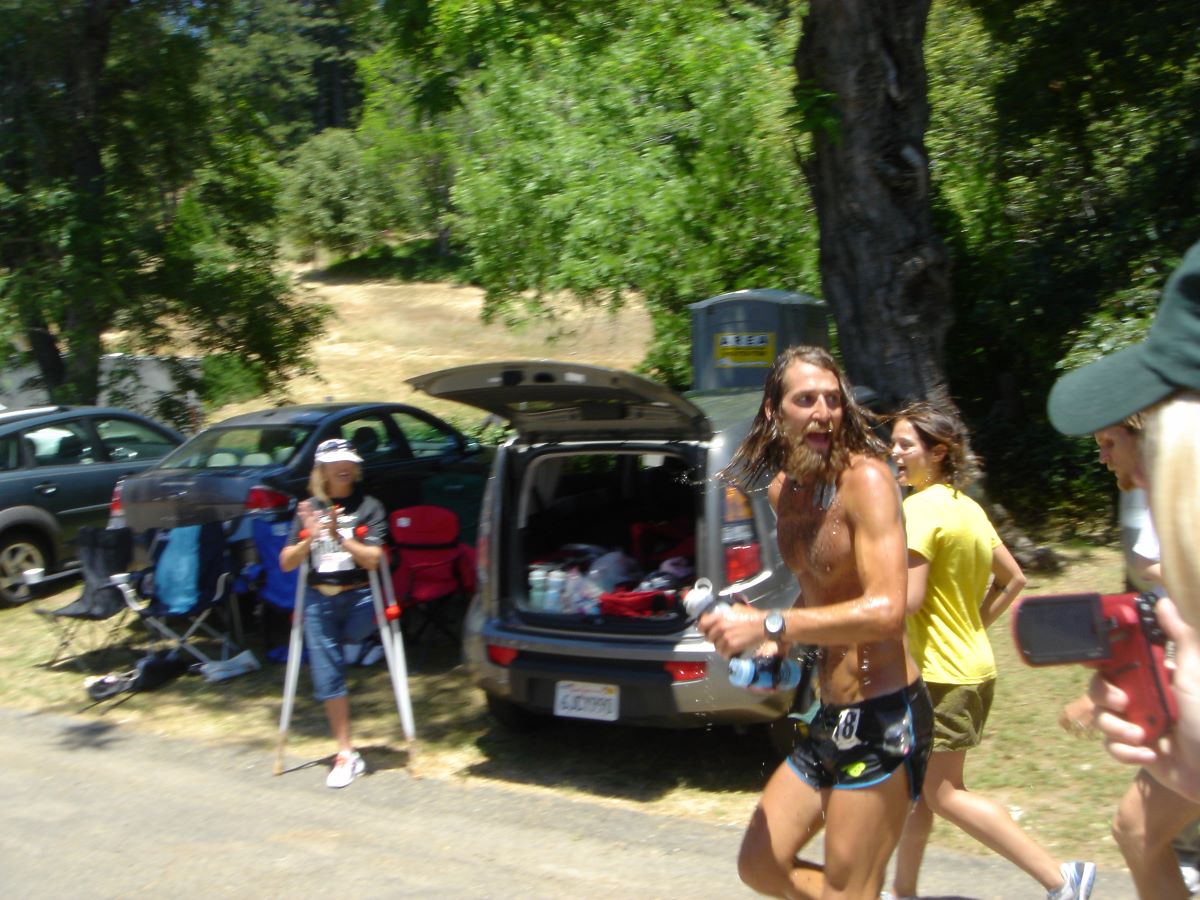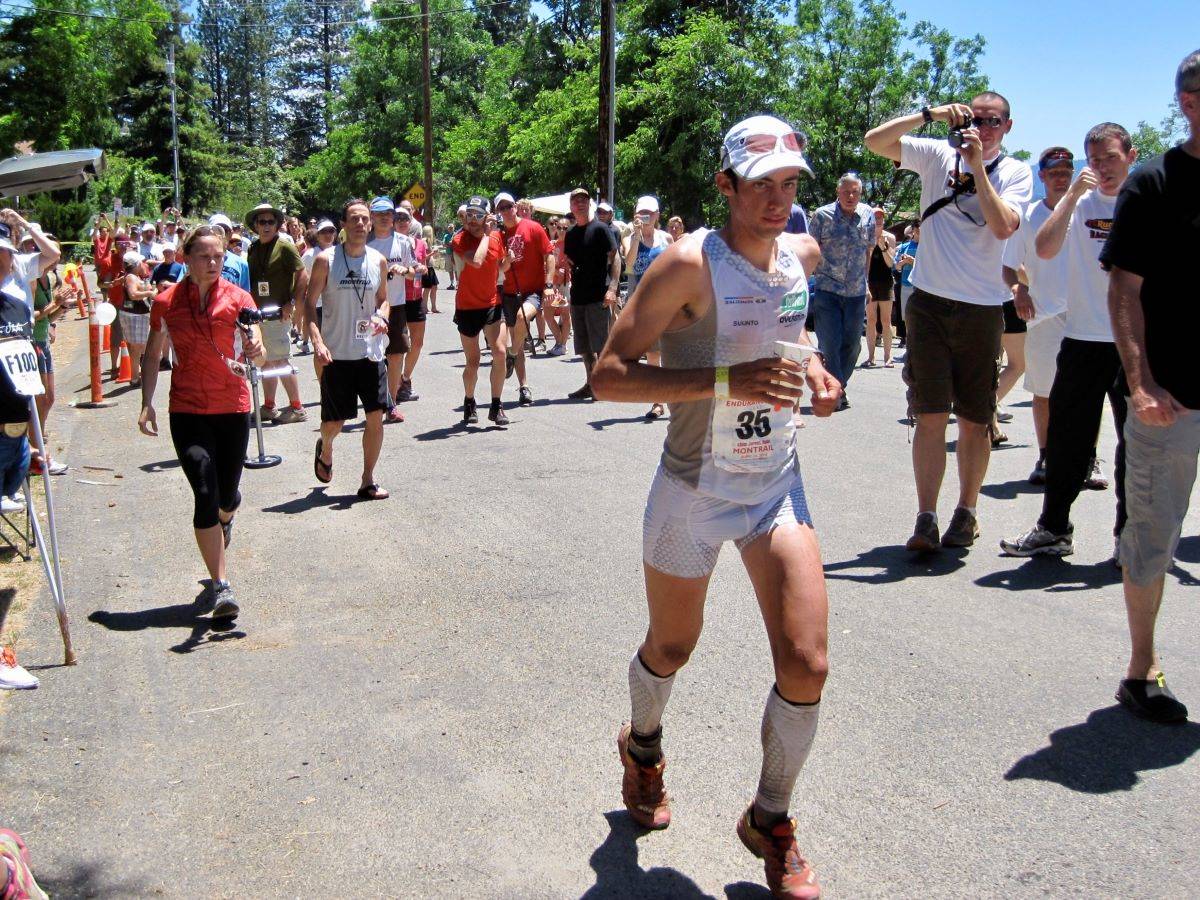[Author’s Note: This is the third in a five-part series on unforgettable moments in ultrarunning history. Read our introductory article on this series for a description of what, to me, makes a moment unforgettable.]
The energy on the starting line was positively electric. It was a few minutes before the start of the 2010 Western States 100 and I was running the race for the seventh time. Having been there so many times before, I was surprised at the realization that this year was somehow different. But it most certainly was. When the gun finally sounded and we took off into the predawn light, four men surged to the front on the initial climb of the race.
Going into the 2010 race, there was tremendous excitement about the strength of the field. In both the men’s and women’s races, there were at least two dozen world-class runners with their eyes on North American ultrarunning’s biggest prize.
At the front of the men’s field were two-time defending champion Hal Koerner, European wunderkind Kilian Jornet, two-time Leadville 100 Mile champion Anton Krupicka, and Alaska’s Geoff Roes who was in the midst of one of the most extraordinary stretches of ultrarunning ever. They were clearly the top class of the field and as I saw them take off on a sprint up the Escarpment, the high point of the race at mile 3.5, I knew why.
For the better part of the first 40 miles, the four leaders stuck closely together. Occasionally, one or the other would move out a bit ahead, but it was not until the descent into Deadwood Canyon at mile 44 that Jornet made an assertive move and opened up a one-minute lead by Devil’s Thumb at mile 47.
By Michigan Bluff at mile 55, Koerner had slipped a few minutes behind and Roes was laboring eight minutes behind. Krupicka and Jornet ran through Michigan Bluff at mile 55 together in course record time. I remember arriving at Michigan Bluff an hour later and my crew telling me, in no uncertain terms, “There is no way you are catching those guys.”
Between Michigan Bluff and Foresthill at mile 62, Jornet and Krupicka continued stride-for-stride in the lead and Roes fell further behind, arriving at the aid station 12 minutes after the leaders, with Koerner pulling in a few minutes after that. From Foresthill to the Rucky Chucky river crossing at mile 78, the two leaders stayed together and Roes fell further back to 15 minutes off the lead. At this point, it looked like a two-man race.
But Geoff Roes had other ideas. Krupicka pulled ahead of Jornet at mile 80, while Koerner dropped out of the race. Roes made an incredible charge, closing to within three minutes of Krupicka at Auburn Lakes Trails at mile 85 and then passing him before Highway 49 at mile 94.
By the time Roes arrived at the Placer High School track, he had run more than one minute per mile faster than Krupicka over the last 20 miles and won the race in a then course record time of 15:06. Krupicka finished second in 15:13 and Jornet third in 16:03.
The women’s race that day was won by Tracy Garneau in 19:01:55, followed in second by Meghan Canfield in 19:15:58 and Nikki Kimball in third in 19:23:09.
The race, in and of itself, was truly memorable, but what makes it an unforgettable moment in ultrarunning is the film that was made about the race and the way it proved to be a watershed moment for the race and the sport.
Reno, Nevada, filmmaker JB Benna and a team of videographers produced “Unbreakable: The Western States 100”— a feature-length film about the race, which chronicled the four male front runners on that day. Using heavy equipment and accessing parts of the course usually only seen by the runners themselves, Benna’s film took viewers into the dynamics of race and exposed millions of viewers to an inside look at the Western States 100.
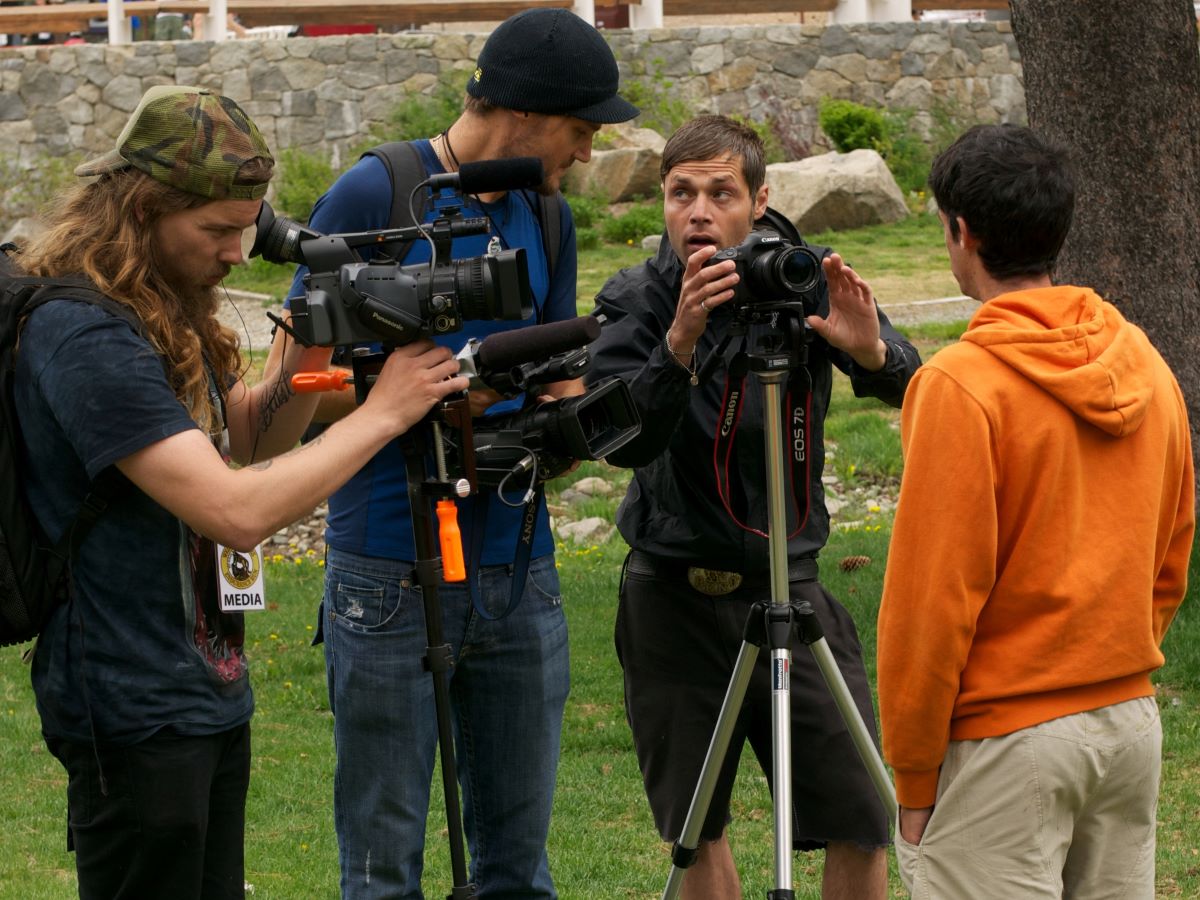
The film crew for “Unbreakable” recording a pre-race interview with Kilian Jornet. Photo courtesy of JB Benna.
Upon its release shortly before the 2011 race, Benna’s film quickly became a cult classic. While there had been previous Western States 100 films — “Desperate Dreams” 1 and 2, “A Race for the Soul,” and “Running Madness” — none got into the guts of the race and the characters in the race quite like “Unbreakable.”
In my view, the release of this film, along with the 2010 publication of “Born to Run,” were the most influential drivers of the trail ultrarunning boom that shortly followed. And, along the way, they turned Roes, Krupicka, Jornet, and Koerner into household names whose fame went well beyond the intimate trail and ultra community.
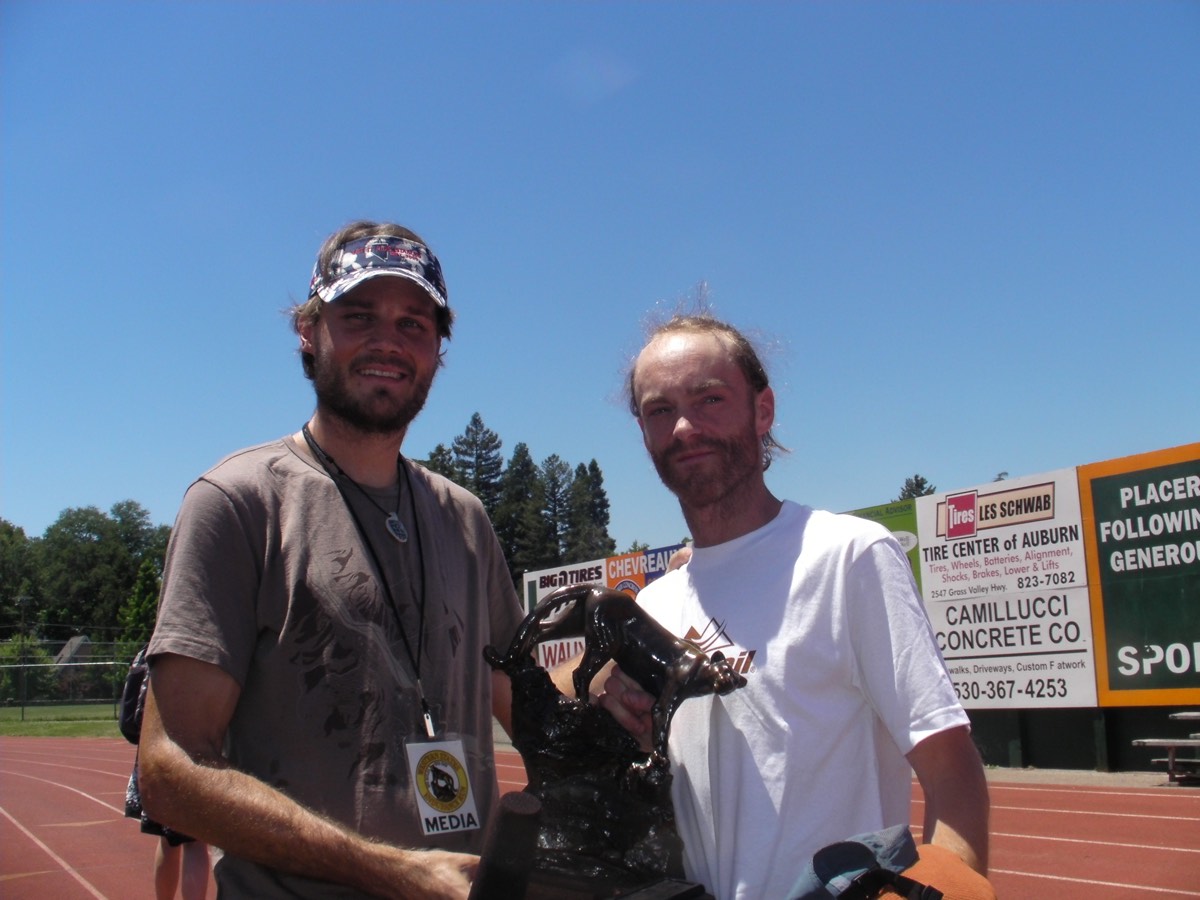
2010 Western States 100 champion Geoff Roes (right) stands with “Unbreakable” filmmaker JB Benna holding his cougar trophy at the Placer High School track where the race finishes. Photo courtesy of JB Benna.
Of course, since “Unbreakable,” we have seen an explosion of films around the Western States 100, as well as dozens of other races. One that’s especially worth a watch is Billy Yang’s “Life in a Day,” which follows four of the top women in the 2016 Western States 100.
All of these films, and the ways in which they provide access for viewers to the events, have inspired a generation to hit the trails. But, to me, “Unbreakable” is the standard-bearer and is, to this day, the bar against which all trail and ultra films should be measured. And that is why the 2010 Western States 100, and the work that it produced, together remain an unforgettable moment in ultrarunning.
Bottoms up!
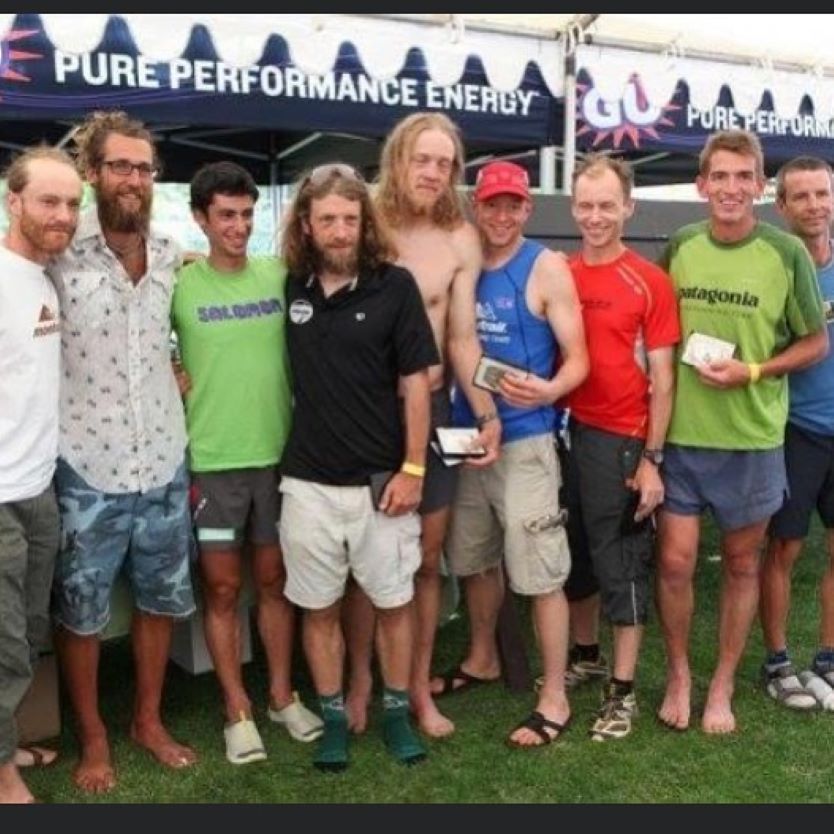
Nine of the Top 10 men after the 2010 Western States 100 men’s race. From left to right: Geoff Roes, Anton Krupicka, Kilian Jornet, Nick Clark, Zachariah Miller, Gary Robbins, Glen Redpath, Andy Jones-Wilkins, and Dan Barger. Eighth-place Ian Sharman is missing. Photo: Joe McCladdie
AJW’s Beer of the Week
 This week’s Beer of the Week comes from Great Basin Brewing Company in Reno, Nevada. Great Basin’s delicious Truckee River Red is a classic red ale that is mildly hopped and slightly sweet. Dry and crisp, this red ale is less cloying than most and is truly refreshing on a hot summer’s day.
This week’s Beer of the Week comes from Great Basin Brewing Company in Reno, Nevada. Great Basin’s delicious Truckee River Red is a classic red ale that is mildly hopped and slightly sweet. Dry and crisp, this red ale is less cloying than most and is truly refreshing on a hot summer’s day.
Call for Comments
- What other trail running and ultrarunning films do you love?
- Are there any that have inspired you in a meaningful way on your own running journey?

